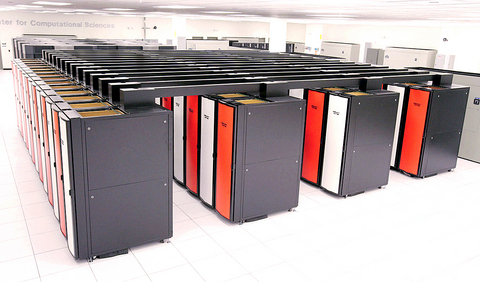The most powerful supercomputer available for general scientific research in the US has doubled its speed, officials said on Friday.
The 54-cabinet Cray XT3 supercomputer at Tennessee's Oak Ridge National Laboratory has been upgraded from 25 teraflops to 54 teraflops, or 54 trillion mathematical calculations per second, they said.
"It is probably the fifth-fastest machine" in the world, said Thomas Zacharia, associate laboratory director. "It is clearly the fastest open science machine in the US today."

PHOTO: AP
The supercomputer, dubbed "Jaguar," was ranked 13th fastest before the upgrade. A list of the 500 most powerful computers in the world is compiled by scientists at the University of Mannheim in Germany, Lawrence Berkeley National Laboratory, and the University of Tennessee.
"The list is a very simple measure, and it is a good thing, obviously," Zacharia said. "But the real winner in these things are the scientists who are running these machines.
"[They] have been very pleased at the initial performance of this upgraded machine," he said. "It is a terrific scientific instrument."
The overhaul was the first step in a multiyear, nearly US$200 million contract between Seattle-based Cray Inc and the US Department of Energy to increase Oak Ridge's supercomputing capability to 1,000 trillion calculations per second, or one petaflop, by 2009.
The current world leader is the nearly six-times-faster 280.6 teraflop IBM Blue Gene/L deployed at the Lawrence Livermore National Laboratory in California and used for national defense purposes.
The Department of Energy has committed to make Oak Ridge's Jaguar available for unclassified peer-reviewed research at least 80 percent of the time.
DreamWorks Animation is interested in using the machine to develop new algorithms for duplicating the effects of light and shade -- called "ray tracing" -- in 3-D animation, Zacharia said. The results could show up in the company's animated feature films or in medical and occupational training.
Boeing Co is hoping the supercomputer will lead to lighter, more energy-efficient airplanes, and General Atomics Co wants to do fusion energy research, duplicating the power of the sun to light homes.
Another 68 cabinets will be added around November to double the supercomputer's speed again to around 100 teraflops. A year later, the installation of new processors should push capacity to 250 teraflops. The lab is expected to swap out Jaguar for the next-generation Cray supercomputer, currently code-named "Baker," in late 2008. At 1,000 teraflops, Baker would be roughly three times faster than any existing computer in the world.

Taiwanese suppliers to Taiwan Semiconductor Manufacturing Co. (TSMC, 台積電) are expected to follow the contract chipmaker’s step to invest in the US, but their relocation may be seven to eight years away, Minister of Economic Affairs J.W. Kuo (郭智輝) said yesterday. When asked by opposition Chinese Nationalist Party (KMT) Legislator Niu Hsu-ting (牛煦庭) in the legislature about growing concerns that TSMC’s huge investments in the US will prompt its suppliers to follow suit, Kuo said based on the chipmaker’s current limited production volume, it is unlikely to lead its supply chain to go there for now. “Unless TSMC completes its planned six

Power supply and electronic components maker Delta Electronics Inc (台達電) yesterday said second-quarter revenue is expected to surpass the first quarter, which rose 30 percent year-on-year to NT$118.92 billion (US$3.71 billion). Revenue this quarter is likely to grow, as US clients have front-loaded orders ahead of US President Donald Trump’s planned tariffs on Taiwanese goods, Delta chairman Ping Cheng (鄭平) said at an earnings conference in Taipei, referring to the 90-day pause in tariff implementation Trump announced on April 9. While situations in the third and fourth quarters remain unclear, “We will not halt our long-term deployments and do not plan to

‘SHORT TERM’: The local currency would likely remain strong in the near term, driven by anticipated US trade pressure, capital inflows and expectations of a US Fed rate cut The US dollar is expected to fall below NT$30 in the near term, as traders anticipate increased pressure from Washington for Taiwan to allow the New Taiwan dollar to appreciate, Cathay United Bank (國泰世華銀行) chief economist Lin Chi-chao (林啟超) said. Following a sharp drop in the greenback against the NT dollar on Friday, Lin told the Central News Agency that the local currency is likely to remain strong in the short term, driven in part by market psychology surrounding anticipated US policy pressure. On Friday, the US dollar fell NT$0.953, or 3.07 percent, closing at NT$31.064 — its lowest level since Jan.

The New Taiwan dollar and Taiwanese stocks surged on signs that trade tensions between the world’s top two economies might start easing and as US tech earnings boosted the outlook of the nation’s semiconductor exports. The NT dollar strengthened as much as 3.8 percent versus the US dollar to 30.815, the biggest intraday gain since January 2011, closing at NT$31.064. The benchmark TAIEX jumped 2.73 percent to outperform the region’s equity gauges. Outlook for global trade improved after China said it is assessing possible trade talks with the US, providing a boost for the nation’s currency and shares. As the NT dollar